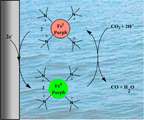Publication
786
Acc. Chem. Res., 48 (12), 2996-3006, 2015
DOI:10.1021/acs.accounts.5b00262
|
|
|
|
|
|
 |
Current issues in molecular catalysis illustrated by iron porphyrins as catalysts of the CO2-to-CO electrochemical conversion |
|
|
|
Cyrille Costentin, Marc Robert, and Jean-Michel Savéant
Université Paris Diderot, Sorbonne Paris Cité, Laboratoire d’Electrochimie Moléculaire, Unité Mixte de Recherche Université - CNRS No. 7591, Bâtiment Lavoisier, 15 rue Jean de Baïf, 75205 Cedex 13 Paris, France
Recent attention aroused by the reduction of carbon dioxide has as main objective the production of useful products, the “solar fuels”, in which solar energy would be stored. One route to this goal is the design of photochemical schemes that would operate this conversion using directly sun light energy. An indirect approach consists in first converting sunlight energy into electricity then using it to reduce CO2 electrochemically. Conversion of carbon dioxide into carbon monoxide is thus a key step through the classical dihydrogen-reductive Fischer–Tropsch chemistry. Direct and catalytic electrochemical CO2 reduction already aroused active interest during the 1980–1990 period. The new wave of interest for these matters that has been growing since 2012 is in direct conjunction with modern energy issues. Among molecular catalysts, electrogenerated Fe(0) porphyrins have proved to be particularly efficient and robust. Recent progress in this field has closely associated the search of more and more efficient catalysts in the iron porphyrin family with an unprecedentedly rigorous deciphering of mechanisms. Accordingly, the coupling of proton transfer with electron transfer and breaking of one of the two C–O bonds of CO2 have been the subjects of relentless scrutiny and mechanistic analysis with systematic investigation of the degree of concertedness of these three events. Catalysis of the electrochemical CO2-to-CO conversion has thus been a good testing ground for the mechanism diagnostic strategies and the all concerted reactivity model proposed then. The role of added Brönsted acids, both as H-bond providers and proton donors, has been elucidated. These efforts have been a preliminary to the inclusion of the acid functionalities within the catalyst molecule, giving rise to considerable increase of the catalytic efficiency. The design of more and more efficient catalysts made it necessary to propose “catalytic Tafel plots” relating the turnover frequency to the overpotential as a rational way of benchmarking the catalysts within iron porphyrins and among all available molecular catalysts, independently of the characteristics of the electrolytic cell in use. To be reliable, such assignments of the intrinsic characteristics of catalysts are grounded in the accurate elucidation of mechanisms. Without forgetting the importance of large scale electrolysis, not only mobilization of all resources of nondestructive techniques such as cyclic voltammetry was necessary to achieve this challenge, but also new approaches, such as foot-of-the-wave analysis combined with raising of scan rate, had to be applied. The latest improvement in catalyst design was to render it water-soluble while preserving, or even augmenting, its catalytic efficiency. The replacement of the nonaqueous solvents so far used by water makes the CO2-to-CO half-cell reaction much more attractive for applications, allowing its association with a water-oxidation anode through a proton-exchange membrane. Manipulation of pH and buffering then allow CO2-to-CO conversions from those involving complete CO-selectivity to ones with prescribed CO–H2 mixtures.
Overall, it appears that not only are iron porphyrins the most efficient catalysts of the CO2-to-CO electrochemical conversion but also they can serve to illustrate general issues concerning the field of molecular catalysis as a whole, including other reductive or oxidative processes. |

